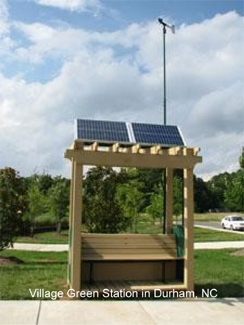Ports Primer: 8.3 Citizen Science Case Studies
The following case studies exemplify the use of citizen science tools:
-
Village Green Project – air monitoring bench provides air quality data to community
-
Ironbound Community-based Environmental Monitoring Study – Citizens from Newark, NJ collect air quality data while piloting air quality monitor.
Air Monitoring Benches Installed for Public Use

Through the Village Green Project, EPA has developed an air monitoring bench that operates on solar and wind power and provides minute-to-minute data on two common air pollutants – ozone and particulate pollution – and weather conditions. The real-time data is publicly available and can better help citizens understand air quality.
EPA is collaborating with state and local partners to further test the air monitoring system, and provide educational outreach on air quality.
For more information: Village Green Project.
Ironbound Community-based Environmental Monitoring Study

EPA is partnered with the Ironbound Community Corporation (ICC) in Newark, NJ to design, develop, and pilot a Citizen Science Toolbox that will enable near-port communities like Ironbound to collect their own environmental data and increase their ability to understand local environmental conditions. In this study, EPA provided technical support for citizens to use a monitoring device called the Citizen Science Air Monitor. Citizens are collecting data for nitrogen dioxide and particulate matterRefers to small particles in the air that can be measured to determine air quality and potential health impacts. Airborne PM can result from direct emissions of particles (primary PM) or from the condensation of certain gases that have themselves been directly emitted or chemically transformed in the atmosphere (secondary PM). PM is often classified by size: PM2.5 and PM10., two types of air pollution that can have significant adverse health effects.
For more information:











